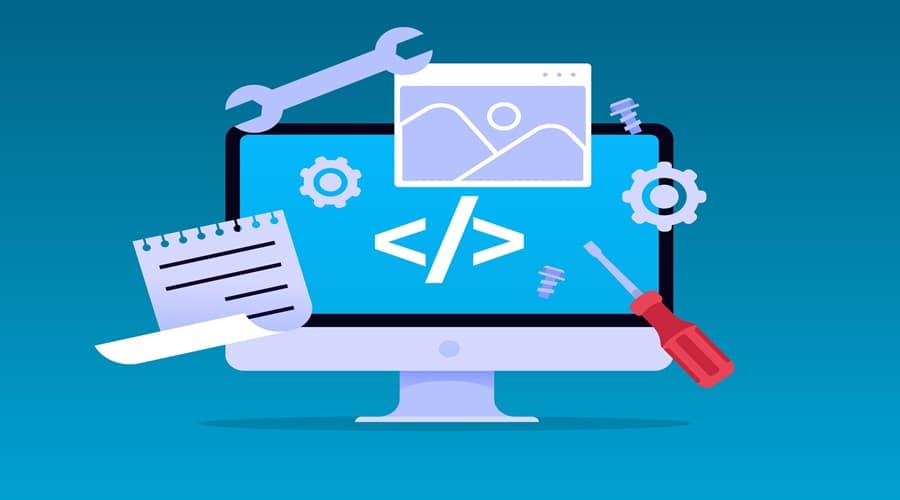
Building Without Boundaries: Explore No-Code SaaS MVP Tools
Are you looking to kickstart your SaaS venture without diving into complex coding? No-Code SaaS MVP Tools offer the perfect solution. These innovative platforms empower entrepreneurs to swiftly develop Minimum Viable Products (MVPs) for their software-as-a-service (SaaS) ideas, eliminating the need for extensive coding knowledge. With a focus on simplicity and efficiency, these tools provide a user-friendly interface and a wide range of customizable features, allowing you to rapidly bring your vision to life. Explore the possibilities and launch your SaaS venture effortlessly with No-Code SaaS MVP Tools.
Why Should You Get into the SaaS Industry?
The SaaS sector provides enterprises and entrepreneurs with many advantages and prospects.
Recurring Revenue Model:
SaaS businesses generate recurring revenue through subscription-based pricing, providing a predictable and stable income stream.
Scalability:
Cloud-based SaaS applications can scale seamlessly to accommodate growing user bases and increasing demand.
Lower Upfront Costs:
SaaS solutions eliminate the need for customers to invest in expensive hardware or software installations, lowering the barrier to entry.
Global Reach:
Because SaaS solutions are accessible from anywhere with an internet connection, firms may reach a worldwide audience.
Continuous Innovation:
SaaS companies can continuously update and improvize software, seamlessly delivering new features and enhancements to customers.
How do I build a No-Code SaaS MVP?
Building a no-code SaaS MVP involves the following steps:
Ideation and Validation:
Identify a problem or pain point your SaaS product aims to solve and validate your idea through market research and customer feedback.
Define Features and User Flows:
Sketch the user interactions and flows after deciding on your MVP’s essential features and functionalities.
Choose a No-Code Platform:
Choose a no-code development platform that meets your needs and provides the resources and capabilities you need to create your SaaS MVP.
Design and Prototype:
Use the platform’s design tools to create mockups, wireframes, and prototypes, ensuring a user-friendly and visually appealing interface.
Build and Integrate:
Utilize the no-code platform’s drag-and-drop interface, pre-built components, and integrations to construct your SaaS MVP without writing a single line of code.
Test and Iterate:
Test your MVP thoroughly on actual users, get their input, and, based on the knowledge you acquire, make necessary design and feature iterations.
Deploy and Launch:
Once satisfied with your MVP, deploy it to the cloud and launch it to the market, allowing early adopters to experience your SaaS product.
Building an app without code: The requirements
Clear Problem and Value Proposition:
Clearly define your problem and the value your SaaS MVP brings to your target audience.
User-Friendly Design:
Prioritize a clean, intuitive, visually appealing design that enhances the user experience and reflects your brand identity.
Core Features and Functionality:
Determine which features and functionalities are necessary for your MVP to offer a minimally viable solution.
Data Management and Storage:
Determine your data storage and management needs and ensure the no-code platform you choose can accommodate them.
Integration Capabilities:
Assess whether you must integrate your SaaS MVP with third-party services like payment gateways, CRMs, or analytics tools.
Scalability and Performance:
Consider the potential growth of your SaaS product and ensure the no-code platform can scale and maintain performance as your user base expands.
Top no-code SaaS MVP tools:
Bubble.io is a powerful no-code platform that empowers users to design and develop web applications and inSoftwareSoftware as a Service (SaaS) products without writing a single line of code. With its intuitive visual editor and extensive library of pre-built components, Bubble.io enables users to create sophisticated and scalable applications quickly and efficiently.
Leading a low-code/no-code platform, Appian helps businesses create enterprise-grade workflows, applications, and automation without requiring complex coding expertise. Appian expedites digital transformation initiatives by offering a wide choice of pre-built tools and integrations with an intuitive UI.
With the aid of Zoho Creator, a versatile no-code platform part of the Zoho suite, users may construct original apps, including SaaS solutions, using easy drag-and-drop tools and pre-built connectors. With Zoho Creator, individuals and businesses can collaborate to develop unique solutions that boost output.
Mendix is a low-code platform that provides enterprise-grade applications, including SaaS solutions, with a visual development environment that eliminates the need for coding. With Mendix’s fusion of visual modeling and agile methodologies, teams can collaborate effectively and produce innovative solutions quickly.
In addition to its renowned CRM software, Salesforce offers a robust low-code/no-code platform that enables users to build custom applications, including SaaS solutions, on top of the Salesforce ecosystem. With its extensive tools, resources, and integrations, the Salesforce Platform empowers businesses to innovate and scale their operations efficiently.
OutSystems is a leading low-code platform that enables organizations to visually develop and deploy web and mobile applications, including SaaS products, focusing on enterprise-level capabilities. By providing a comprehensive set of features, including visual development tools, pre-built templates, and seamless integrations, OutSystems accelerates application delivery and drives digital transformation initiatives.
With AppGyver, users can create SaaS solutions and progressive web apps without writing code using a visual editor, pre-built components, and integrations. With AppGyver’s simple interface and customizable deployment choices, people and organizations can construct cutting-edge, feature-rich applications without knowing any code.
Betty Blocks is a no-code platform with a visual development environment and pre-built templates that enable users to construct enterprise-grade programs, including SaaS products. With Betty Blocks ‘ integration tools and flexibility, businesses may innovate swiftly and adapt to changing market needs.
The visual development platform Webflow allows users to create, construct, and publish responsive websites without knowing any code. It is a well-liked option for developers and designers because it provides an extensive feature set, including e-commerce features, a drag-and-drop editor, and CMS capabilities.
Wix Corvid, formerly known as Wix Code, is a no-code platform that uses Wix’s user-friendly editor to develop dynamic websites and custom web applications. Users can add sophisticated features to their Wix sites without knowing any code, integrate Corvid with third-party APIs, and access backend development tools.
Airtable is a versatile no-code database platform that combines spreadsheet and database functionality. Its user-friendly interface allows users to collaborate and organize their data. Airtable can also be integrated with other apps and services to automate workflows and optimize procedures.
Thunkable is a no-code platform designed for iOS and Android smartphone application development. With its simple drag-and-drop interface, users can create native mobile apps without any coding experience. Features like in-app purchases, push alerts, and GPS tracking can be added.
Glide is a no-code platform that enables users to create mobile apps directly from Google Sheets. By connecting Google Sheets to Glide’s platform, users can turn their data into fully functional mobile apps with interactive features and real-time updates, making it ideal for projects such as event management, inventory tracking, and more.
Adalo is a no-code platform designed to create iOS and Android mobile applications. With its drag-and-drop UI and user-friendly capabilities, users can create visually appealing apps with features like data integrations, user authentication, and custom layouts. Adalo expedites the app development process by offering components and templates as well.
Kintone is a low-code platform that enables businesses to build custom applications for various purposes, including project management, CRM, and workflow automation. With Kintone’s visual interface and pre-built templates, users can design and deploy applications tailored to their needs without extensive coding. Kintone also offers robust collaboration and integration capabilities to enhance productivity and efficiency.
FAQs:
Do I need any coding skills to build a no-code SaaS MVP?
No, the best thing about no-code platforms is that they let you create working apps—including SaaS MVPs—without having to write any code. Nonetheless, having a fundamental understanding of programming ideas can be helpful.
How much does it cost to build a no-code SaaS MVP?
The cost of developing a no-code SaaS MVP may change depending on the platform you select and its price plan (e.g., monthly membership, pay-per-use, etc.). Many platforms provide initial free or inexpensive plans, with the opportunity to upgrade as your SaaS product expands.
Can I build complex SaaS applications with no-code platforms?
While no-code platforms are designed to simplify the development process, they still have limitations in terms of complexity and customization. Consider low-code platforms or traditional coding methods for advanced or highly specialized SaaS applications.
Are no-code SaaS MVPs scalable and performant?
The platform you select and the intricacy of your application will determine how scalable and performant no-code SaaS MVPs are. Scalability and performance are important considerations for many no-code platforms, but before committing, assessing your unique needs and the platform’s capabilities is critical.
How secure are no-code SaaS applications?
Reputable no-code platforms strongly emphasize security, implementing secure hosting, data encryption, access controls, and regular security updates. However, reviewing the platform’s security documentation and practices is always recommended to ensure they align with your requirements.
Can I customize the look and feel of my no-code SaaS MVP?
Most no-code platforms come with various design tools and customization choices that let you give your SaaS MVP a distinctive appearance that complements your brand. Nonetheless, in contrast to conventional coding techniques, personalization might be constrained.
Conclusion:
The number of no-code development tools has increased, making it easier to build a SaaS MVP without knowing any code. These technologies enable innovators, enterprises, and entrepreneurs to swiftly and affordably realize their SaaS ideas without requiring high technical skills. You can focus on validating your product idea, identifying key features, and developing an MVP that is easy to use and addresses a pressing issue for your target market by utilizing no-code platforms. Without writing a single line of code, you can create a working SaaS MVP, test it with potential users, and make iterations based on feedback if you have the correct platform and a firm grasp of your objectives.




